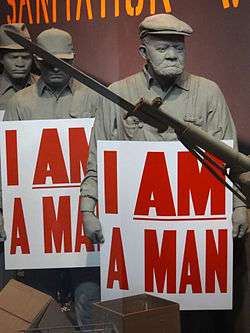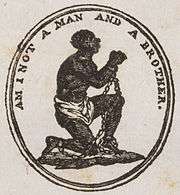I Am a Man!

I Am a Man! is a declaration of civil rights, often used as a personal statement and as a declaration of independence against oppression.
Am I Not a Man?

Historically, in countries such as the United States and South Africa, the term "boy" was used as a pejorative racist insult towards men of color and slaves, indicating their subservient social status of being less than men.[1] In response, Am I Not A Man And A Brother? became a catchphrase used by British and American abolitionists. In 1787, Josiah Wedgwood designed a medallion for the British anti-slavery campaign. He copied the original design from the Society for Effecting the Abolition of the Slave Trade as a cameo in black-and-white. It was widely reproduced and became a popular fashion statement promoting justice, humanity, and freedom.[2]
The question "Am I Not A Man?" was brought up again during the Dred Scott decision of the U.S. Supreme Court.[3] During the Civil Rights Movement at the Memphis sanitation strike in 1968, "I AM A MAN!" signs were used to answer the same question.[4]
On trial for bringing his son back to Nebraska for burial, from a forced march to Oklahoma, in 1879 Ponca Chief Standing Bear spoke to judge Dundy in his Omaha trial, "That hand is not the color of yours, but if I pierce it, I shall feel pain. If you pierce your hand, you also feel pain. The blood that will flow from mine will be the same color as yours. I am a man. God made us both." Standing Bear (and Native Americans) were granted habeas corpus meaning that they had status in the court and were indeed human beings.[5]
Modern use
"I Am a Man!" has been used as a title for books, plays, and in music[6] and film[7] to assert the rights of all people to be treated with dignity. "I Am a Man!" signs were used in Arabic language Ana Rajul during the Arab Spring.[8]
Other uses
- The Elephant Man declares, "I am not an elephant! I am not an animal! I am a human being! I ... am ... a ... man!"
See also
References
- ↑ Andersen, Margaret L. (2008). Sociology With Infotrac: Understanding a Diverse Society. Thompson Learning. p. 61.
- ↑ Dabydeen, David (February 17, 2011). "The Black Figure in 18th-century Art". BBC News. Retrieved December 18, 2012.
- ↑ Am I Not a Man? by Mark L. Shurtleff. Reviewed by Robert Fleming. AALBC.
- ↑ Miami Herald
- ↑ "I Am a Man": Chief Standing Bear's Journey for Justice, Joe Starita 2010.
- ↑ Ron Miles, "Ron Miles: I Am A Man", All About Jazz, October 27, 2017.
- ↑ Marc Myers, "Mining the Memphis Sound", The Wall Street Journal, June 17, 2011.
- ↑ Ben Shapiro, "Dark Forebodings of the Arab Spring", Frontpage Magazine, May 20, 20110.